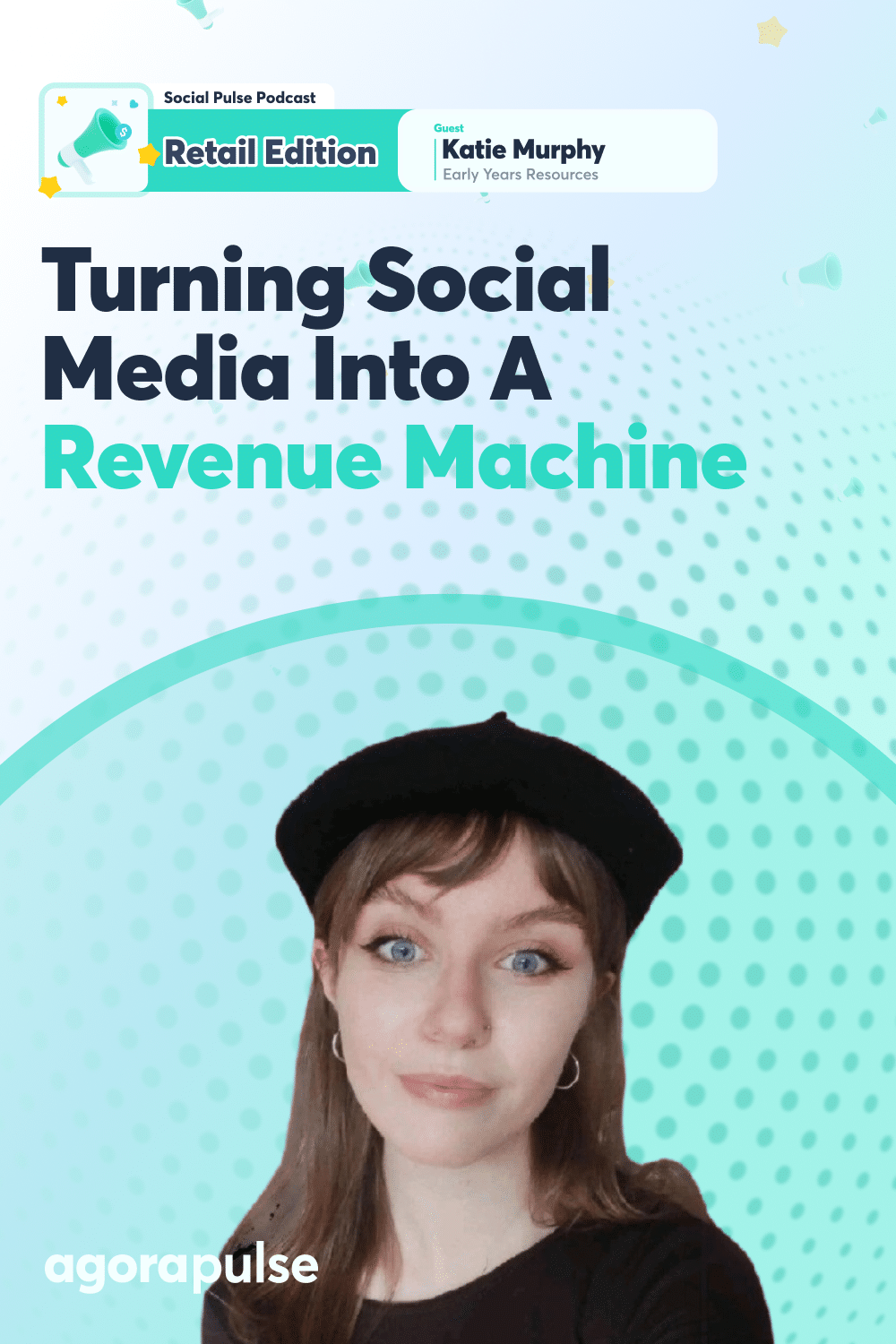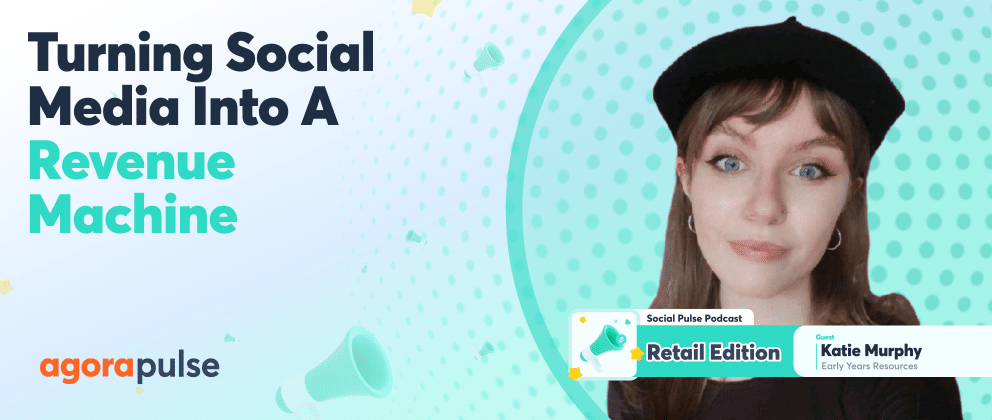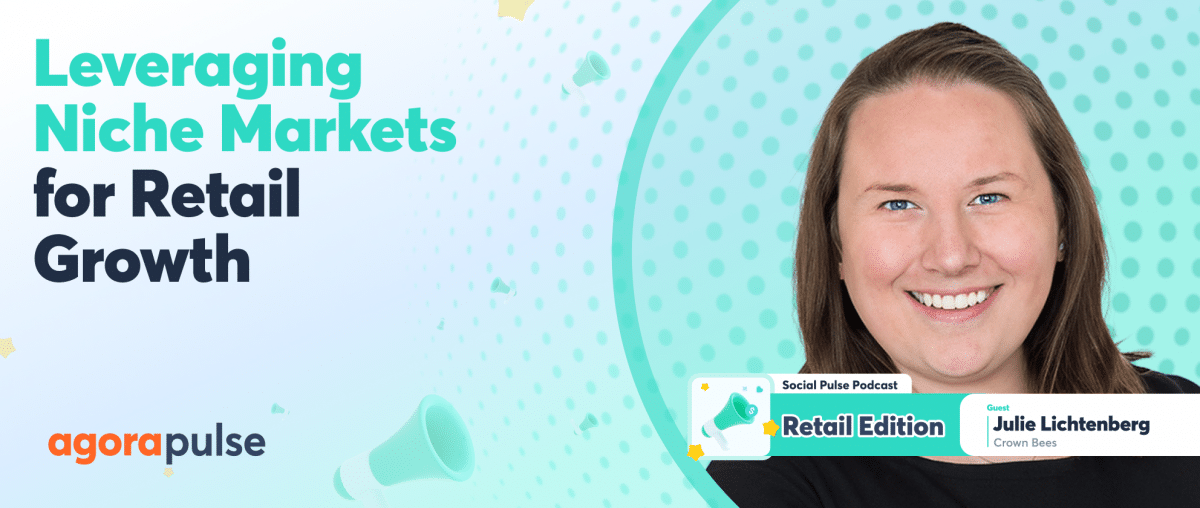What if you could transform your social media presence from a cost center into a social media revenue-generating machine?
For too many retail brands, social media success is still measured by vanity metrics, likes followers, and reach. But what if there was a better way?
And that’s exactly what Agorapulse’s Chief Storyteller Mike Allton explores with today’s guest Katie Murphy, head of social media at Early Years Resources. Katie has revolutionized how her company approaches social media measurement, driving a stunning 341 percent increase in direct revenue from social media and a 236 percent increase in conversions. Today, she’s here to share exactly how she did it and how you can, too.
[Listen to the full episode below, or get the highlights of the Social Pulse: Retail Edition, powered by Agorapulse. Try it for free today.]
Introducing Early Years Resource and Social Media Revenue
Mike Allton: Before we dive into the metrics, tell us a bit about Early Years Resources and the role that social media plays in your overall marketing strategy.
Katie Murphy: Early Years Resources is a leading supplier of educational resources. We’re based in Manchester in the UK. We sell resources to Early Years professionals, teachers, and schools, and going into 2025, we’re working on high schools, older students, and maybe some after-school clubs as well.
Social media is quite central to our marketing strategy because it enables us to reach the teachers that we’re trying to connect with. I don’t know how it is in the US, but over in the UK, typically for—I mean, our company has been going for 30 to 33 years nearly. Typically our marketing efforts used to be [that] we’d put a catalog together, and we’d send it through the mailbox of schools. But the catalog typically gets stopped at reception. The receptionist has the power in terms of “Will the catalog be distributed amongst the people that we want to buy from us?”
Social media gets around that a little bit because it enables us to connect with educators and parents in a way that a catalog probably couldn’t on the platforms that they use daily. It serves as quite a powerful channel for brand awareness, community engagement, and driving traffic to our website, as well as complements our broader digital and offline marketing efforts.
Mike Allton: That’s fascinating. It is a little bit different here in the U.S. I know teachers in schools buy some of their supplies, but I also know their budgets are too low for them to get all the supplies that they need. They end up emailing parents before school starts, “Hey, could you bring all these things with your students?”
I could see them following a brand like yours and looking to you for guidance on specifically which supplies and which brands and things they need.
Katie Murphy: Yeah, that’s a trend that we’re seeing in the UK as well with teachers buying their supplies.
Again, they don’t necessarily have the budget to be able to do things like that. It’s nice to be able to connect with them on social media, answer any questions that they might have, and let them know that we have free resources for them. Just generally have that kind of supportive networking available to them.
Initial Challenges of Connecting Social Media Success to Social Media Revenue
When you first started to try to connect your social media efforts with some actual business results, what were some of the initial challenges that you ran into?
Katie Murphy: One of the key challenges was tracking issues. So difficult to link those social media efforts directly to sales or leads!
I think a lot of social media professionals will probably concur with that. It’s difficult to say, “Oh, this sale directly came from this organic post.” ‘Cause how would you know? There was also maybe a lack of awareness as to what social media could do. Or maybe focusing too much on the likes and the followers which didn’t necessarily impact the overall business. And then things like understanding the customer journey. Like, identifying how social media then influences purchasing decisions as well.
Measuring Real Business Impact vs Vanity Metrics
What were some of the first steps that you took to shift then from tracking those vanity metrics to measuring what you and I would consider a real business impact?
Katie Murphy: I will say first, it takes a village.
It’s not just me. We do have a small but mighty marketing team who always put so much effort into everything. Teamwork is the main thing. Teamwork and aligning our goals amongst each other to drive overall business efforts.
In terms of social media, before I got there three years ago, we’d already introduced conversion tracking through pixels—such as the Facebook Pixel and Google Analytics—to measure that ROI effectively. Recently, maybe a year and a half ago, we introduced the Pinterest Pixel as well because I started advertising [on Pinterest].
One of the problems was a lack of consistency before I got there with paid media specifically. Some months looking back on what people had done before, there were months where there was a lot of spend. Then the following month they’d spend maybe 20 pounds for the whole month.
Again, [with a] small company, it’s difficult to have someone purely focused on one thing when you’re running quite a tight ship. It’s not a big deal. It’s just that it was probably difficult to have one person focused directly on that. So there was a lack of consistency.
Step One: High Spend Periods Baked Into Organic Strategy
One of the first steps was setting out an actual strategy for seeing where high spend periods were for schools, teachers, etc. And then aligning our paid strategy to those periods to then also complement our organic strategy. High spend periods typically for a retail brand would probably be like the Christmas period or Valentine’s Day for some brands. For schools in the UK, it’s slightly different because the school will get a set budget for the year every April, and so they have that money to spend. Usually, the last or first three months of the year (January through March) still have that spend.
That ends up being basically a period of high spend. Those are the months that I was focusing on with the paid media.
That complements our organic strategy.
Step Two: Clear Objectives
[Another one] of the first things that we did was set clear objectives as well. Like, what do we want to do with this? It is our job to get people to the website. Do we just want anyone on the website? Obviously not. Or do we want those like high conversion customers? Do we want people who spend a lot? That was all part of it.
Step Three: Align Goals and UTM Tracking
Always align those goals with the broader business objectives. I don’t know if it’s a simple step, but implementing UTM tracking to monitor how specific posts actually impact campaigns and influence traffic and conversions.
You’ve got your UTM tags on Facebook ads or whatever, but it also implemented them into organic posts just trying to get people to the blog. Then, at the end of the month, to be like, “This post managed to get people to the website and you can see directly because of this exact link.”
There were a lot of small steps, I think, but [they] ended up having a pretty big impact in terms of how I could report.
Mike Allton: The UTM tracking is huge because to your earlier point, if you’re not doing UTM parameter tracking, then that means you have no idea if a link shared in a post or a comment or a direct message does anything. Google Analytics won’t differentiate the use of a specific link. It just says, “Hey, here’s Facebook traffic. Hope it was great. We have no idea!”
For those reading, if you’re not familiar, UTM codes are little parameters that you add to a link. It just lengthens the link. The link still works the same for the end user, but those codes are read by Google Analytics. They can tell what the campaign is, what the source is, if it’s Facebook or X or LinkedIn, what the medium is, if it’s social media or email or private messaging.
This was something that one of our Agorapulse customers came to us about several years ago. She was managing social media for another UK company called Brayola. She was talking to our CEO, and she was complaining about the fact that when she sent out an email, every link was automatically tracked. When she does paid advertising, every single link is automatically tracked. But when she posts content through Agorapulse, the links aren’t tracked. This was the same pretty much with every social media tool. So we implemented automatic UTM parameters added to every single link, whether it’s a scheduled post a comment, or a direct message.
Try Agorapulse for FREE today, and take your retail brand social media revenue to the next level.
So then we integrated with Google Analytics so that we could pull all that data in from Google Analytics and show you, “It was this direct message that you sent last month that resulted in a purchase.” So a huge point I’m glad you brought up.
Measuring Social Media Revenue Approach
Could you walk us through how you’re approaching measurements—whether that’s a whole framework or using reports? What metrics do you track now that you weren’t tracking before?
Katie Murphy: In terms of metrics that we track, my two biggest goals as a social media manager are brand awareness and traffic. Revenue and conversions are part of that, but it’s not.
Social media for our company isn’t the main source of conversions.
In terms of awareness metrics, it includes reach and follower growth. Controversially, I do think those vanity metrics do have an impact on social media. I think a strong follower count and a high like-to-post ratio do have a positive first impression on users. It signals credibility and trustworthiness for new visitors, those kinds of metrics can maybe encourage them to explore further or engage with the company as well.
“Those likes and follows act like a gateway to maybe a deeper interaction, including conversion or revenue for the company. They might eventually want to connect with you or visit your profile, share your posts, and then eventually lead to purchase over time.
It’s controversial, I know, but I see no problem with tracking those vanity awareness metrics.”
In terms of engagement, we have an engagement rate, which I think is very important—especially when I’m working with influencers. Comments, saves, and shares become a much bigger thing as we move into the coming year.
I don’t know if you saw Adam Mosseri’s Instagram Live talking about the importance of shares and how that’s one of the biggest things for organic media. We also have traffic metrics, like click-through rates, and website sessions sourced from social media. That’s where I use Google Analytics mostly, the conversions. That’s where I come in on paid media. Sales are attributed to social efforts.
Using Facebook, Meta ads, and Pinterest ads to see how many conversions I’m getting from my paid posts.
The one metric that maybe we didn’t focus on previously was the cost per acquisition. But I feel like that’s quite important, and it feels like something that I am quite interested in. I like to see how that goes from, like, I don’t have loads of time to put on paid media, but I’d like to see how that’s impacted week-to-week, month-to-month.
Pinterest is a very low cost per acquisition, so you can see how it jumps sometimes. It’s interesting to think about why that happens.
Mike Allton: I could not agree more with your perspective on quote-unquote “vanity metrics”. It’s this challenge where it’s easy to focus on those.
That’s why we call them vanity metrics because some people, that’s all they want to look at because it makes them feel good that they have more followers. But if you’re doing it right (the way that you are, Katie) you’re paying attention to what those followers are doing next or what those people who are engaging with posts are doing next.
In those instances, if you’re doing it right, that means you’re attracting the right people. We want those followers to grow. Not every parent and not every educator in the entirety of the UK follows your social brands. Of course, there are people out there that you want to continue to reach, and there are new parents every year as new kids come into the school system.
There’s always that growth that you want to tap into.
ROI Reports and Metrics
How are you presenting all of these social media ROI reports and metrics to your leadership team? Are there any particular structures or ways of reporting that you’ve found to be more effective than others?
Katie Murphy: I’ve been there for three years now, just over. I remember when I first started—this is my kind of my second role in social media—and I was so aware that I wanted to get across the importance of social media, what we were doing, and show how that was impacting the business.
When I first started, I used to put up these massive spreadsheets. Completely unreadable things just to show like, “Hey, I’m doing something!” That’s not an effective way to get across anything, which I quickly learned.
The way that I do it is we have monthly meetings. We have a weekly catch-up with the marketing team just about what we did last week and what’s coming up next week. That’s quite effective because it means that in a tight little community, we have an idea of what everyone’s doing. I then have my monthly meetings with the wider team, including the marketing team and the wider business.
In those kinds of things, I find a very basic simplified return, like an ROI kind of presentation, to show what we’ve done, what we spend, “this is our return, this is the best performing.” It’s quite visual, I would say. Obviously, green is good, and red is bad. And then also have that narrative storytelling within those presentations explaining how the campaigns that I run. The marketing team running alongside me has aligned and affected those broader business goals as well.
On top of those, we have quarterly strategy reviews to align efforts with the higher leadership priorities as well.
But I would say one of the most effective things I’ve started doing is presenting things more visually more graphs, less tables.
Learn more retail insights, strategies, and wisdom from our experts in every episode of Social Pulse: Retail Edition.
Tools to Track Social Media Revenue
Are there any other tools that you’re using to help you track and keep up with all these different metrics and reports?
Katie Murphy: We used to use Buffer up until very recently just for scheduling and very basic insights. I don’t know if paranoid is the right word, but I get quite into my analytics. I like to cross-reference things anyway. And I do find sometimes with third party, it takes a lot more time, but I do find with third-party apps, sometimes their understanding of what one analytic is isn’t the same as the in-platform. And so it just gets a bit messy.
I tend to just use the in-platform insights.
- I like TikTok’s updated their insights recently. You can have a look on the web instead of just on your phone, which is always an option. Instagram as well. I quite like their insights.
- Notoriously, Meta Business Suite is not the one, but for basic insights just to see or just to report on things like brand awareness metrics, it tends to do the job for me.
- Recently, also as well, we’ve just started on TikTok Shop, which has been interesting, and something that I hope we’re going to continue into 2025. But I will say I do like the back end of TikTok Shop. I don’t know if [you’ve] tried it at all, but I like the way similar to Google Analytics, you can track that customer journey. “Did they come from a specific video that you put out, or have they been to your profile and then gone to TikTok Shop?” I like it.
Mike Allton: It’s interesting because I’m not an e-commerce brand, so I’ve only been able to see at a high level what it can do, but it’s really impressive what I’ve seen so far. It reminds me of some of the older platforms because you’re right. A lot of them today, like Facebook’s Ad Manager and the Meta Business Suite, are challenging to use and to get the information you want out of it. TikTok is a breath of fresh air where you get to the metrics you’re looking for, and you get to them easily. Speaking of TikTok, I know you’re just crushing it on TikTok. You managed to generate 30 million organic views on TikTok in six months.
Viral Content vs Social Media Revenue Drive
How do you balance doing that viral content creation with actual social media revenue-driving activities?
Katie Murphy: It is hard because—like we were saying earlier with the vanity metrics—it’s such a serotonin boost to see that video go viral. You’re refreshing the page all the time. Oh-so exciting, but you do have to balance it out if you’re going to balance what you’re doing in terms of brand awareness with the bottom line, essentially.
In terms of balancing that out, the main thing is to create a segmentation for your posts. Having that mix of entertaining educational and promotional posts and understanding as well that those promotional posts are probably not going to have that instant serotonin boosts that a viral entertaining video might have. But they could potentially have more of an impact when it comes to conversions and revenue.
It’s all about testing and learning.
Analyze which viral trends are aligning with your audience’s interests. I have fun conversations with various WhatsApp groups and LinkedIn chats about the struggles of social media managers.
One of the things is, “With all these interest days, how do you decide what you’re going to put out?” And we had a really funny conversation about, “Well, I’m not going to have anything for National Hotdog Day because why would I?” It doesn’t align, but you see maybe some brands say, “Oh, it’s National Coffee Day.” Well, why are you posting this? You’re not a barista, or you’re not Starbucks, or whatever.
It’s all about understanding how these days or trends align with your social media interests and your audience’s interests.
Understand that you don’t have to get on every trend. Then we obviously measure KPIs for both engagement and viral content and conversion, so promotional content as well.
It’s difficult to balance out, but you’ve got to do it. Otherwise, you’ll be running around like a headless chicken trying to keep on top of all the trends that come out all the time.
Proving Your Worth
How would you advise other social media managers who are struggling to prove their value in these ways?
Katie Murphy: It’s all about data. I get very bogged down in the data. I love a spreadsheet. I feel like a detective when I’m looking at it.
I don’t want to know the why. Like, “Why has this thing gone viral? Why have so many people landed on our website this month?” So it’s all about data. You can’t argue with that.
- As we were saying earlier, presenting that data effectively in a way that you can present to your leadership is the actual impact.
- You can’t argue with that because these are the facts, it’s data. I think that’s just step one. It’s a winner.
- Next, you have to show how that engagement drives things like traffic, leads, or sales.
- Again, you might have to educate leadership a little bit by explaining the importance of what you’re doing, like brand awareness and community building.
(It can seem, I guess, a bit wishy-washy if you can’t present the data on how that is driving things that they care about. You could use case studies on a campaign that you’ve just run with like those real-life examples of how a campaign that you run has affected business growth. Or whatever your goal is.)
- And then you can focus on incremental wins as well.
- You should be highlighting the short-term successes while also working on those long-term goals.
I just wanted to point out briefly, things like the engagement feeling a bit wishy-washy, do you have a case study for that? Obviously we get quite a few viral videos on TikTok. We’ve worked out a way that we can—not predict because that would be virtually impossible—but a way that we know that that’s going to resonate with our audience.
One of the viral videos that we had was using one of our most popular products. It’s called a Tough Tray Paper Pad and is essentially a massive hexagonal piece of paper, but it slots nicely into these trays, and teachers like to use them. So we used this video and ended up generating millions and millions of views on TikTok, which was lovely.
There’s that serotonin boost. But also we managed to get 26 sales of the product, and we could attribute that to TikTok via Google Analytics. It’s important to have those tools in place as well.
There are UTM tags to show where those customers have come from and what their journey is and, because of the ability to attribute those sales to TikTok, you can then demonstrate the impact of social media as a whole.
Thanks for reading the highlights from this episode about social media revenue. Don’t forget to find the Social Pulse Podcast: Retail Edition on Apple or Spotify, where we’re digging into the challenges, successes, and stories of social media and community professionals in the industry, just like you.
Until next time!






